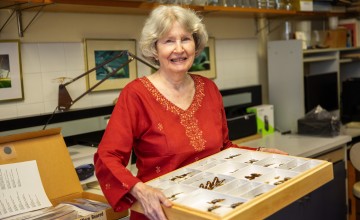
Annette
Aiello
A butterfly pupa masquerades as a snake head, a bagworm never leaves its case of silk and sand until it reaches adulthood, beetle larvae stow away in biodegradable packing peanuts. Sound a bit like science fiction? These natural history stories are real.
Research Focus
I have studied insect life histories for the last 40 years. My main focus has been the transformations of moths and butterflies, especially caterpillar development, behavior and defenses, and the clues that they and their host plants can contribute to our understanding of species relationships. My publications include other subjects too — beetles, leafhoppers, insect outbreaks, mimicry, and even sloth hair, as well as plants, reflecting my early interest in botany, which I pursued on my own until entering college in my late 20s, and later was the subject of my Ph.D. thesis.
Contact
Research Overview
How do tropical insects protect themselves?
Like insects everywhere, tropical insects are just trying to stay alive long enough to reproduce. They use a variety of strategies to avoid predators and to find food and mates. In the tropics, where there are more species of plants and animals than in colder regions, the tricks they use, and their interspecies interactions, can be much more complex.
What are tropical insects doing and why?
They're doing all the regular things that everybody does. Eating and sleeping and reproducing and avoiding predators. There is no end to the intricacies of their forms, behaviors, and defenses. For example, there are caterpillars that make escape holes in their leaves and construct stalactites of fecula and silk to guide them to those holes; others live in rolled leaves and keep their fecula there as barriers to predatory wasps and ants; others live communally in silk sacks, in which they pupate together; still others live together in the open and follow each other on silk trails that they lay from one feeding site to another and to their molting places on their tree trunk.
What can immature stages of insects tell us about their evolutionary relationships?
The immature stages — caterpillars and pupae — are totally different from the adults, and they're evolving independently. That's been shown with frogs. If you do a cladogram for the tadpoles and the frogs, you will get a different set of species relationships. There are limits to that separate evolution, or they wouldn't be able to transform from one to the other.
What can knowledge of host plants tell us about insect evolutionary and relationships?
George Vogt learned that with certain of his weevils. He found that in North America they are on oaks (Fagaceae), where they suffer from predatory weevils that are related to them, and which attack their eggs, but when they get into Mexico and South America, they switch to plants of the Anacardiaceae and they drop their predators. So, the consequences for changing plants can be good ones.
Education
B.A., Biology, magna cum laude, Brooklyn College, 1972
M.A., Biology, Harvard University, 1975
Ph.D., Biology, Harvard University, 1978; Thesis: "A Reexamination of Portlandia (Rubiaceae) and Associated Taxa" (Dr. Richard A. Howard, advisor).
Selected Publications
Aiello, Annette, A. 2021. “Jaws: a powerful trunk-girdling longhorn, Trachysomus thomsoni Aurivillius, 1923 (Cerambycidae: Lamiinae: Onciderini) in Panama.” The Coleopterists Bulletin 75(3):531-536.
Aiello, A. & Stucky. B. 2020. "First host plant record for Pacarina (Hemiptera: Cicadidae)." Neotropical Biology and Conservation, 15(1): 77–88. https://doi.org/10.3897/neotropical.15.e49013
Aiello, A. 2019. “Amorphosoma penicillatum (Klug, 1827) (Coleoptera: Buprestidae: Agrilinae): A fearless jewel beetle in Panama.” Coleopterists Bulletin 73(4): 1102–1104.
Brashears, J., Aiello, A. & Seymoure, B. 2016. "Cool bands: Wing bands decrease rate of heating, but not equilibrium temperature in Anartia fatima." Journal of Thermal Biology 56:100—108.
Aiello, A., Saltonstall, K., & Young, V. "Brachyplatys vahlii, an introduced bug from Asia: first report in the Western Hemisphere (Hemiptera: Plataspididae: Bracyplatidinae)." BioInvasions Record, 5(1):7—12.
Aiello, A. 2015. Tropical caterpillar addiction. In: Dyer, Lee A. and Forister, Matthew L., The lives of lepidopterists. Springer International Publishing, pp.91‑102.
Seymoure, B. & Aiello, A. 2015. "Keeping the band together: evidence for false boundary disruptive coloration in a butterfly." Journal of Evolutionary Biology, 28(2015):1618—1624. doi: 10.1111/jeb. 12681
Aiello, A. 2015. "Oncideres Serville Key to Too Few: 34 Species Lost." The Coleopterists Bulletin 69(1):60.
Domínguez Núñez, Edwin & Aiello, A. 2013. "Leaf‑hoppers (Homoptera: Cicadellidae) that probe human skin: a review of the world literature and nineteen new records, from Panama." Terrestrial Arthropod Reviews 6(2013):201-225.
Donald, D., Quintero A., D., Cambra T., R., & Aiello, A. 2008. "Biology of a new Panamanian bagworm moth (Lepidoptera: Psychidae) with predatory larvae, and eggs individually wrapped in setal cases. Annals of the Entomological Society of America 101(4): 689-702.
Van Bael, S.A., Aiello, A., Valderrama, A., Medianero, E., Samaniego, M., & Wright, S.J. 2004. General herbivore outbreak following an El Niño‑related drought in a lowland Panamanian forest. Journal of Tropical Ecology, 20(6):625‑633.
